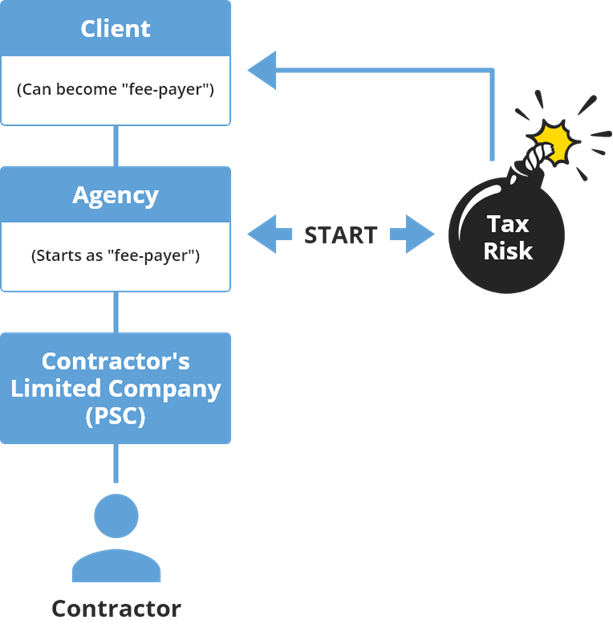
The reforms to IR35, enacted in April 2021, resulted in new legislation called Off-payroll working, which applies where contractors work for medium to large companies. This guide explains the key terms within the legislation concerning the supply-chain and where the tax risk sits.
Off-payroll & IR35 – same, but different
IR35 is a non-statutory colloquial term used to describe two sets of tax legislation designed to combat tax avoidance where workers are supplying their services to clients via an intermediary, such as a limited company, but who would be considered an employee if the intermediary was removed.
The original IR35 is the Intermediaries Legislation (Chapter 8 of ITEPA 2003) enacted in 2000, which now only applies to workers working for small firms. The new legislation is the Off-payroll working legislation (Chapter 10 of ITEPA 2003), which rolled out to the private sector in April 2021.
There are considerable differences between the original legislation and the new legislation. However, the common theme is the concept of a “deemed employee” and ascertaining whether tax implications must be followed.
If the original legislation applies, then the worker is responsible for assessing whether they are “Inside IR35” (rules apply) or whether they are “Outside IR35” (rules do not apply) and then paying the appropriate extra taxes if necessary.
Under the Off-payroll legislation, the “client” should consider whether the relationship is “deemed employment” and the “fee-payer” is required to pay the taxes – but who are these parties in the supply chain?
Off-payroll & IR35 – the key terms
The critical terms contained within the legislation to understand are:
- Client
- Fee-payer
- Intermediary
- Worker
The parties then fit into the supply chain, as defined within the legislation.

Off-payroll & IR35 – who is the “worker” and the “client”?
Section 61M(1)(a) tells us who “the worker” and “the client” are:
61M Engagements to which Chapter applies
- Sections 61N to 61R apply where—
(a) an individual (“the worker”) personally performs, or is under an obligation personally to perform, services for another person (“the client”),
We, therefore, know that the “client” is the hiring firm for whom the personal work is being provided.
The “worker” is the contractor, who will be working via their limited company, sometimes referred to as a Personal Service Company (PSC), a colloquial term to describe a one-person incorporated business.
Off-payroll & IR35 –what is the “chain”?
Section 61N(1) tells us what the “chain” is:
61N Worker treated as receiving earnings from employment
1. If one of Conditions A to C is met, identify the chain of two or more persons where—
(a) the highest person in the chain is the client,
(b) the lowest person in the chain is the intermediary, and
(c) each person in the chain above the lowest makes a chain payment to the person immediately below them in the chain.
The conditions A to C essentially tell us whether there is a PSC in the supply chain which needs to be considered.
From the definitions, we know the “client” is the one at the top, and the bottom one is the intermediary, via which the worker provides their services personally.
Off-payroll & IR35 – who and what is the “fee-payer”?
If the arrangement is assessed as one where the worker is a deemed employee, often referred to as “Inside IR35”, taxes need to be deducted and paid to HMRC, with the PSC receiving an amount net of taxes paid.
The party that must pay the taxes is called the “fee-payer”, and Section 61N(2) tell us that this is the party above the “lowest”, which means the one above the intermediary. The “fee-payer” then pays the intermediary an amount of money referred to as the “chain payment”. When that gets paid, and is treated as employment income, it is referred to as the “deemed direct payment.”
61N Worker treated as receiving earnings from employment
- …
- In this section and sections 61O to 61S—“chain payment” means a payment, or money’s worth or any other benefit, that can reasonably be taken to be for the worker’s services to the client,
“make”—
(a) in relation to a chain payment that is money’s worth, means transfer, and
(b) in relation to a chain payment that is a benefit other than a payment or money’s worth, means provide, and
“the fee-payer” means the person in the chain immediately above the lowest.
Off-payroll & IR35 – how can the fee-payer and tax risk switch back to the client?
There is, however, a situation whereby the “fee-payer” can return to being the client, rather than the party below them in the chain.
Section 61N(5) tells us that:
(5) Unless and until the client gives a status determination statement to the worker (see section 61NA), subsections (3) and (4) have effect as if for any reference to the fee-payer there were substituted a reference to the client; but this is subject to sections 61V and 61WA
Subsections (3) and (4) are about the necessity to pay the taxes by treating the payment made (“deemed direct payment”) as employment income.
If the determination is “Inside IR35”, where taxes need to be paid, the next party in the chain, if there is one, must pay the taxes, and if they don’t, the tax risk sits with them, and not the client – provided the client passed them an SDS.
Off-payroll & IR35 – what is a Status Determination Statement (SDS)?
A ‘Status Determination Statement’ (SDS) is a comprehensive statement from the client which:
- Declares a contractor’s deemed employment status following an IR35 assessment
- Provides reasons for reaching this conclusion.
- Is only valid if the client took ‘reasonable care’ in arriving at its decision
This legislative requirement for an SDS was introduced in April 2021 and is intended to help combat misclassification of status due to non-compliant blanket or role-based assessments.
Despite a common misconception, no legislative requirement says an SDS must be produced or passed down – but failure to do so results in the consequences outlined in 61N(5), where the fee-payer can switch back to the client.
For a belt-and-braces compliance approach, IR35 Shield recommends that assessments and Statement Determination Statements are used in all cases and shared with the next party in the supply chain and the worker.
Key takeaways
Main points for all parties:
- Make sure you understand which party is the “client” and which is the “fee-payer” in your chain.
- The “fee-payer” can change, depending on whether a Status Determination Statement (SDS) is valid and/or whether it is given to the worker.
- Not all SDS’s are equal.
Whether you are a contractor or a client, choose an expert partner to help manage your assessment process.



